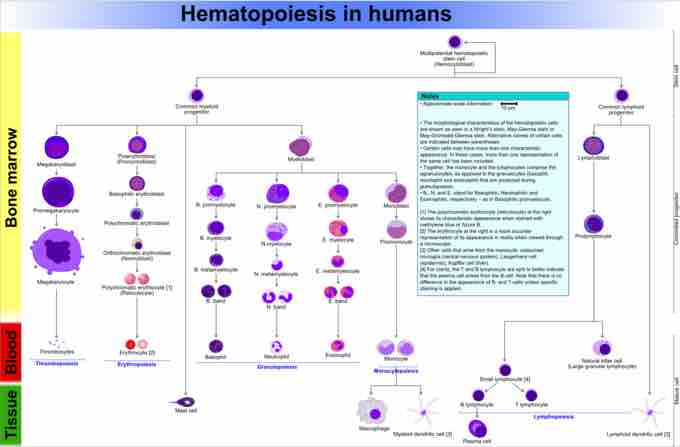The cells of the adaptive immune system are a type of leukocyte, called a lymphocyte. The human body has about 2 trillion lymphocytes, constituting 20-40% of white blood cells (WBCs); their total mass is about the same as the brain or liver. The peripheral blood contains 20–50% of circulating lymphocytes; the rest move within the lymphatic system. B cells and T cells are the major types of lymphocytes.
B Cell and T Cell Differentiation
Mammalian stem cells differentiate into several kinds of blood cell within the bone marrow. This process is called haematopoiesis . During this process, all lymphocytes originate from a common lymphoid progenitor before differentiating into their distinct lymphocyte types. The differentiation of lymphocytes into distinguishable types follows various pathways in a hierarchical fashion as well as in a more plastic fashion. The formation of lymphocytes is known as lymphopoiesis. B cells mature into B lymphocytes in the bone marrow, while T cells migrate to, and mature in, a distinct organ called the thymus. Following maturation, the lymphocytes enter the circulation and peripheral lymphoid organs (e.g. the spleen and lymph nodes) where they survey for invading pathogens and/or tumor cells.

Hematopoeisis in humans
Mammalian stem cells differentiate into several kinds of blood cell within the bone marrow. This process is called haematopoiesis. All lymphocytes originate during this process from a common lymphoid progenitor before differentiating into their distinct lymphocyte types.
Further Differentiation
The lymphocytes involved in adaptive immunity (i.e. B and T cells) differentiate further after exposure to an antigen; they form effector and memory lymphocytes. Effector lymphocytes function to eliminate the antigen, either by releasing antibodies (in the case of B cells), cytotoxic granules (cytotoxic T cells) or by signaling to other cells of the immune system (helper T cells). Memory cells remain in the peripheral tissues and circulation for an extended time ready to respond to the same antigen upon future exposure.